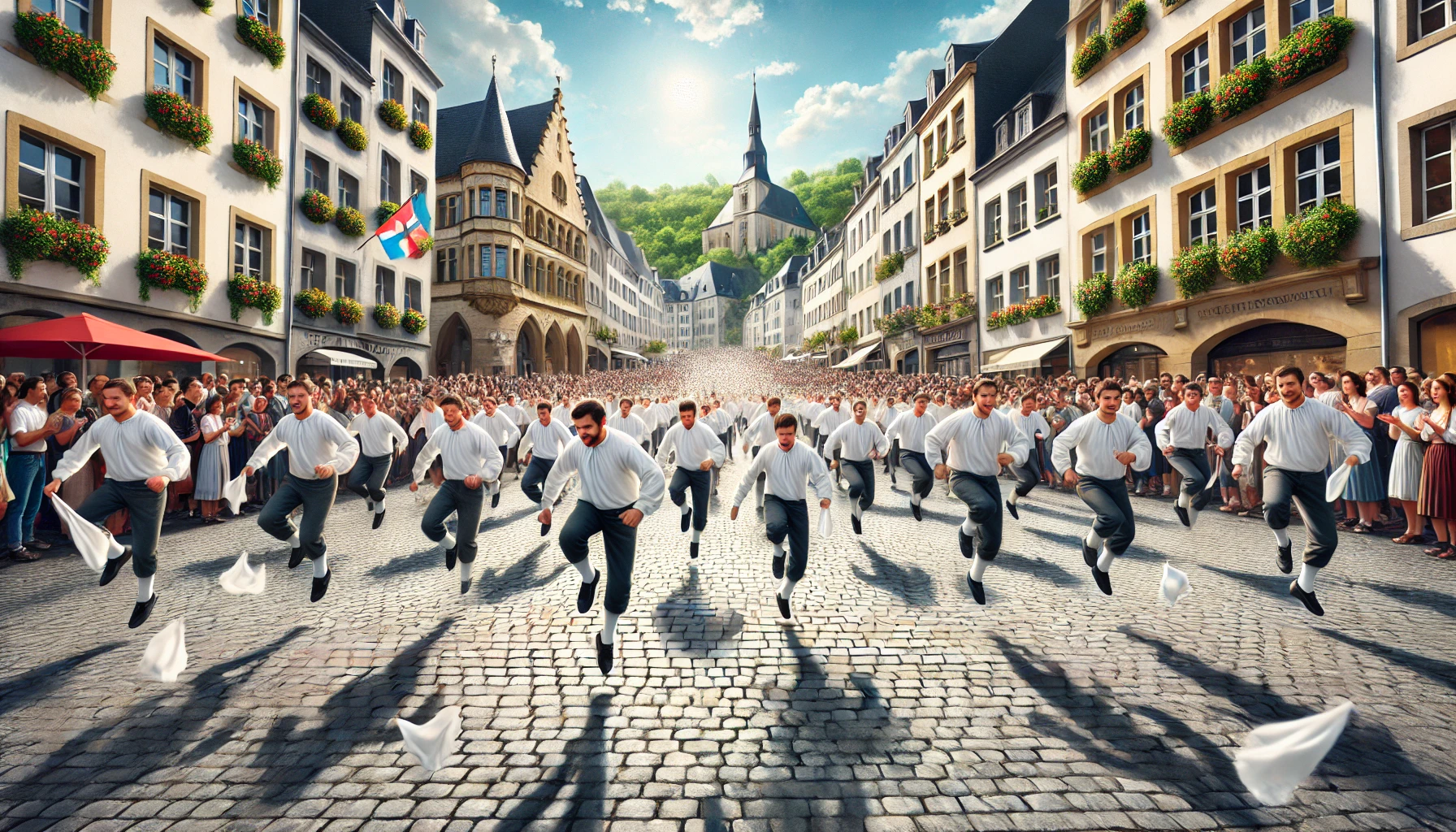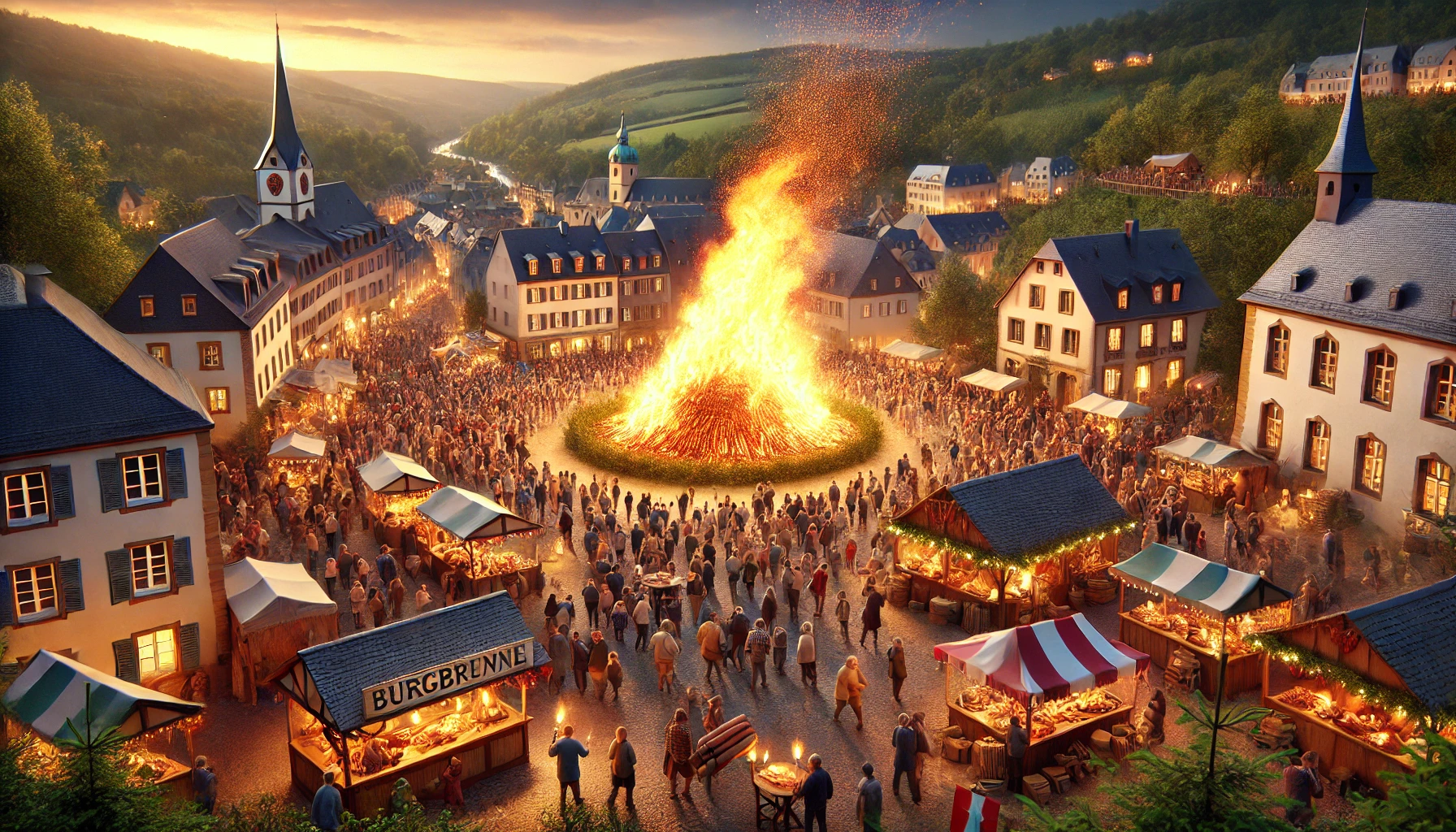What Other Unusual Traditions Can Be Found in Luxembourg?
Luxembourg, though one of Europe’s smallest nations, is rich in culture, history, and unique traditions. Its customs are deeply rooted in a mix of Celtic, Germanic, and Roman influences, making it a fascinating destination for cultural enthusiasts. Beyond its picturesque landscapes and cosmopolitan capital, Luxembourg’s traditions reveal a deep commitment to community, faith, and celebration.
1. The Hopping Procession (Iechternacher Sprangprëssessioun)
One of Luxembourg’s most iconic and unusual traditions is the Hopping Procession of Echternach. This annual event takes place on Whit Tuesday, drawing thousands of participants and spectators to the small town near the German border.
What Is the Hopping Procession?
The Hopping Procession involves groups of participants dressed in white shirts and dark trousers, who hop through the streets of Echternach to the rhythm of a polka-like melody. They hold on to white handkerchiefs and hop in unison, creating a mesmerizing and unique spectacle.
Historical and Religious Roots
Honoring St. Willibrord: The procession dates back to the Middle Ages and is held in honor of St. Willibrord, the patron saint of Luxembourg. Willibrord, an Anglo-Saxon missionary, established a monastery in Echternach in the 7th century, which became a major religious center.
Healing Rituals: Originally, the hopping was believed to be a healing ritual for people suffering from diseases like epilepsy, earning the procession its nickname, the "dance of the jumping saints."
UNESCO Recognition
In 2010, the Hopping Procession was added to UNESCO’s list of the Intangible Cultural Heritage of Humanity, highlighting its cultural significance and the community spirit it fosters.
Why It’s Special
The event is a unique blend of faith, tradition, and rhythm. It brings together locals and visitors in a shared experience that’s both solemn and joyful, reinforcing a sense of unity and devotion.

2. Buergbrennen (Burning of the Bonfires)
As winter loosens its icy grip, Luxembourg welcomes spring with Buergbrennen, or the Burning of the Bonfires. This fiery tradition is celebrated on the first Sunday after Carnival, symbolizing the end of winter and the arrival of warmer days.
What Happens During Buergbrennen?
The festivities begin with a torchlight procession, as locals carry torches to the top of a hill where a large wooden cross or pyre has been erected. Once the bonfire is lit, the community gathers to watch the flames illuminate the night sky. The event is often accompanied by music, laughter, and traditional foods.
Cultural and Historical Significance
Pagan Origins: The tradition has its roots in pagan rituals, where fire was used to chase away evil spirits and cleanse the land in preparation for the growing season.
Community Gathering: Over time, Buergbrennen evolved into a communal celebration that strengthens social bonds and provides an opportunity for neighbors to come together.
Traditional Foods and Drinks
No Buergbrennen celebration is complete without local delicacies. Mulled wine, grilled sausages, and pastries are typically enjoyed around the fire, adding a cozy and festive atmosphere to the event.
Why It’s Special
Buergbrennen isn’t just a visual spectacle—it’s a symbol of renewal and hope. The flickering flames, laughter, and shared moments make it a cherished tradition that celebrates both nature and togetherness.

3. Bretzelsonndeg (Pretzel Sunday)
Love and pretzels go hand in hand on Bretzelsonndeg, or Pretzel Sunday, a charming tradition celebrated on the fourth Sunday of Lent. This quirky custom involves gifting pretzels as tokens of affection.
The Tradition
For Men: On Pretzel Sunday, men traditionally give pretzels—often made of puff pastry and adorned with sugar or chocolate—to women they admire or love.
Leap Year Twist: In leap years, the roles are reversed, with women giving pretzels to men.
Symbolism of the Pretzel
The pretzel, with its twisted shape, is believed to symbolize arms crossed in prayer, tying the tradition to Luxembourg’s Christian heritage. It also represents the bond of love and friendship.
Cultural Significance
Bretzelsonndeg adds a touch of sweetness to the Lenten season, turning it into a time of romantic gestures and playful traditions. It’s a reminder that love and appreciation can be expressed in the simplest yet most meaningful ways.
Modern Celebrations
While the tradition remains rooted in its romantic origins, it has also become a fun family activity, with bakeries creating colorful and elaborate pretzels for everyone to enjoy.
4. Fuesend (Carnival Festivities)
Carnival in Luxembourg, known locally as Fuesend, is a colorful and joyful celebration that takes place between Candlemas (February 2nd) and Ash Wednesday. This festive season is marked by parades, music, and unique rituals that vary across towns and villages.
What Happens During Fuesend?
Fuesend is an explosion of creativity and community spirit:
Masked Balls and Parades: Locals dress in elaborate costumes and masks, participating in lively parades filled with floats, music, and dancing.
Stréimännchen (Burning of the Straw Man): This symbolic act marks the end of the Carnival season. A straw figure, representing winter and the hardships of the past year, is ceremoniously burned, ushering in a fresh start.
Cultural Significance
Fuesend is more than just a party—it’s a communal event where creativity and tradition come together. It provides an outlet for self-expression, strengthens community bonds, and serves as a joyful farewell to winter.
Local Highlights
Diekirch Cavalcade: One of Luxembourg’s largest Carnival parades, featuring colorful floats and performances.
Remich’s Stréimännchen: The burning of the straw figure in Remich is a must-see tradition, drawing crowds from across the country.
5. Dräikinneksdag (Epiphany)
Celebrated on January 6th, Dräikinneksdag marks the Feast of the Epiphany, honoring the visit of the Three Wise Men to the baby Jesus. While this Christian holiday is observed across Europe, Luxembourg adds its own twist to the celebration with the tradition of the Dräikinnekskuch (King’s Cake).
What Is the Dräikinnekskuch?
The Dräikinnekskuch is a sweet, flaky pastry filled with almond cream. Inside the cake is a hidden bean or figurine, and the person who finds it is crowned king or queen for the day.
Family Tradition: Families gather to share the cake, with the finder of the bean receiving a paper crown and the honor of “royalty” for the day.
Fun for All Ages: Children especially delight in the tradition, often hoping to be crowned king or queen.
Why It’s Special
Dräikinneksdag combines religious significance with playful fun, creating a tradition that brings families and communities together. It’s a sweet way to start the new year while celebrating Luxembourg’s cultural heritage.
6. Liichtmëssdag (Candlemas)
On the evening of February 2nd, Luxembourg comes alive with the soft glow of lanterns during Liichtmëssdag, a beloved tradition that involves children, music, and sweets.
What Happens on Liichtmëssdag?
Children carry handmade lanterns and go door-to-door singing traditional songs in exchange for treats. The most popular song begins with the words, “Léiwer Härgottsblieschen,” a plea for blessings and good fortune.
Lanterns: These are often made at school or home, with designs ranging from simple paper constructions to elaborate creations.
Sweets and Treats: Neighbors reward the children’s songs with candies, coins, or small gifts.
Cultural Significance
Liichtmëssdag has deep roots in Christian traditions, symbolizing the purification of Mary and the presentation of Jesus at the temple. Over time, it evolved into a community-focused event that marks the transition from winter to spring.
Why It’s Special
The tradition fosters a sense of togetherness and brings joy to neighborhoods. It’s a charming way for children to engage with their heritage while spreading light and warmth during the cold winter months.
7. Geenzefest (Broom Festival)
Luxembourg’s traditions extend beyond its Christian roots to include celebrations of local flora. The Geenzefest, or Broom Festival, held annually on Whit Monday in the town of Wiltz, is a vibrant tribute to the broom plant.
What Is the Geenzefest?
The festival honors the broom plant, which grows abundantly in the surrounding hills. The event features:
Parades: Floats adorned with broom branches wind through the streets, accompanied by marching bands and dancers.
Cultural Exhibits: The festival showcases local crafts, music, and traditional costumes.
Food and Drink: Attendees enjoy regional specialties, including hearty stews and locally brewed beer.
Why It’s Special
Geenzefest highlights the strong connection between Luxembourg’s people and their natural environment. It’s a lively celebration that brings the community together while promoting local traditions.
8. Bretzelsonndeg (Pretzel Sunday)
Luxembourg’s Bretzelsonndeg, or Pretzel Sunday, is one of the most endearing and playful traditions of the year. Celebrated on the fourth Sunday of Lent, this custom combines romance, community, and a touch of humor.
What Happens on Pretzel Sunday?
The tradition revolves around the exchange of pretzels:
For Men: Typically, men gift intricately decorated pretzels—ranging from simple dough to chocolate-covered treats—to the women they admire or love.
Leap Year Twist: In leap years, the roles are reversed, and women give pretzels to men.
Symbolism of the Pretzel
The pretzel’s distinctive shape is said to resemble arms folded in prayer, symbolizing goodwill, affection, and spiritual devotion. Over the centuries, it has also come to represent romantic gestures and courtship.
Community Celebrations
Beyond its romantic origins, Bretzelsonndeg is also a time for families to enjoy seasonal pastries together. Bakeries create an array of colorful and delicious pretzels, making the day a feast for both the heart and the taste buds.
9. Geenzefest (Broom Festival)
One of Luxembourg’s most vibrant celebrations, Geenzefest takes place annually on Whit Monday in the town of Wiltz. This festival is a joyous tribute to the broom plant, which has cultural and historical significance for the region.
The Festival Atmosphere
Wiltz transforms into a lively hub of parades, music, and community activities:
Parades: Floats adorned with yellow broom branches wind through the town, accompanied by dancers in traditional costumes.
Local Crafts and Cuisine: Artisans showcase their crafts, and food stalls serve regional specialties, including broom-flavored schnapps.
Cultural Significance
The broom plant symbolizes resilience and the connection between Luxembourg’s people and their natural environment. By celebrating this humble shrub, Geenzefest underscores the importance of local traditions and the beauty of rural life.
Why It’s Special
Geenzefest is a testament to Luxembourg’s ability to turn even the simplest elements of its landscape into vibrant, meaningful celebrations.
10. The Role of Traditions in Luxembourg’s Cultural Identity
Luxembourg’s traditions go beyond their festive nature—they serve as a reflection of the country’s history, values, and community spirit. From ancient rituals like the Hopping Procession to lighthearted customs like Pretzel Sunday, these practices create a shared sense of belonging and pride.
Preservation of Heritage
Many of Luxembourg’s traditions, such as the Hopping Procession and Buergbrennen, have been passed down for centuries, connecting modern-day Luxembourgers to their ancestors. These events serve as living links to the past, ensuring that the nation’s history remains alive and celebrated.
Community Bonds
Festivals like Fuesend and Liichtmëssdag bring neighborhoods together, fostering collaboration and connection. They provide opportunities for families, friends, and strangers to come together in celebration, strengthening social ties.
Cultural Recognition
Luxembourg’s efforts to preserve its traditions have earned global recognition. The Hopping Procession, for example, is listed as a UNESCO Intangible Cultural Heritage, showcasing the nation’s dedication to safeguarding its cultural legacy.
Conclusion: A Nation of Rich Traditions
Luxembourg may be small in size, but its traditions are grand in their cultural significance and heartfelt execution. From the solemn yet rhythmic Hopping Procession to the romantic charm of Pretzel Sunday, each custom highlights the nation’s ability to balance history, community, and celebration.
These traditions not only attract visitors from around the world but also instill a deep sense of pride among Luxembourgers. By embracing and preserving these unique customs, Luxembourg continues to stand out as a vibrant and culturally rich nation, inviting everyone to explore its fascinating heritage.
Whether you’re drawn to the rhythmic hopping of Iechternacher Sprangprëssessioun, the glowing lanterns of Liichtmëssdag, or the sweet exchanges of Bretzelsonndeg, Luxembourg offers a tapestry of traditions that are as unusual as they are unforgettable.
